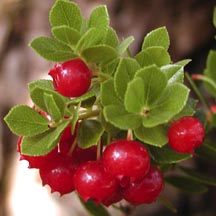
In the Garden![]()
Rick Barboza
’Ohelo
LATIN NAME
Vaccinium reticulatum
These berries are a favorite of Pele’s
Description: Small shrubs, 3 to 4 feet tall, with stiff aerial roots and rounded leaves, usually with many tiny serrations on the margins. Leaves are generally pale green with reddish-pink margins. Flowers are tubular and generally dark red but sometimes light pink, green or even yellow. Occasionally, a single flower will fade from dark red to green at the tip.
The berries for which this plant is famous are generally bright red, but color can vary, with some plants having yellow, purplish-red, orange, pink or even black fruit. This plant is highly variable, so characteristics such as serrated/nonserrated leaf margins, fruit or flower color, size and shape, will vary, especially between different island populations.
HUI KU MAOLI OLA
Distribution: V. reticulatum is found predominantly in higher subalpine and alpine shrub lands of Maui and Hawaii, from about 2,000 feet to well above 10,000 feet in elevation. It is also found on new lava flows and cinder cones. Occasionally, plants can be found on Kauai, Oahu and Molokai, but normally different native species of 'ohelo are more common in those regions.
Cultural uses: 'Ohelo is among the few native Hawaiian plants to produce palatable fruit; in fact, another name for this plant is 'ohelo 'ai, edible 'ohelo. The berries have always been a treat as is, but more recently have been used to make tangy jams, jellies and ono-licious pies.
Fruiting branches of the plant are thrown into Kilauea Crater as offerings to Pele. This may mean carrying the branches great distances, as 'ohelo is not found near the crater. It is also common when eating 'ohelo to offer the first berry to Pele by throwing it in the general direction of Kilauea, regardless of what island you are on.
The flowers' nectar serves as food for some Hawaiian honeycreepers, such as 'amakihi and 'i'iwi. The berry itself is the favorite food of the nene, or Hawaiian goose. The flowers and fruit are also used in lei making.
Landscape use and care: Unless you live in Volcano on the Big Island or in Upcountry Maui, the chances of your having 'ohelo are very slim. We were able to grow it at our nursery, but the plants are very sensitive to water and light. We did get them to flower and fruit, but we ended up with only enough berries to make one of those little complimentary jelly packets that you normally get when ordering toast at restaurants.
Also: The genus for 'ohelo, Vaccinium, is the same as for blueberries and cranberries.
Rick Barboza co-owns Hui Ku Maoli Ola, a native Hawaiian plant nursery, with Matt Schirman. Contact him at 259-6580 or e-mail rickbarboza@aol.com.
Gardening Calendar


